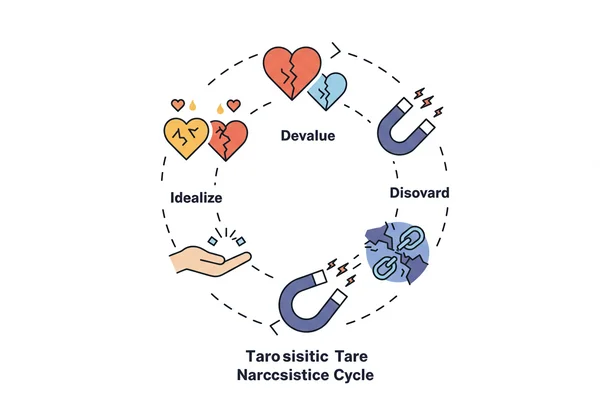The Narcissist Test: Understanding the Abuse Cycle from Love Bombing to Discard
Is your relationship a constant rollercoaster? Are you adored one day and ignored the next? This dizzying shift from intense highs to devastating lows isn't just a rough patch—it's a recognized pattern. If this sounds familiar, you may be experiencing the narcissistic abuse cycle, a destructive pattern of behavior common in relationships with individuals high in narcissistic traits. How can a relationship that started so perfectly turn so painful? Understanding this cycle is the first critical step toward gaining clarity and protecting your emotional well-being. This guide will break down the predictable phases, helping you recognize the patterns for what they are. For those seeking deeper insight, a free narcissist test can be a valuable tool for reflection.
Understanding the Narcissistic Relationship Pattern
A relationship with a narcissist rarely follows a healthy, linear path of growth and mutual respect. Instead, it operates in a distinct, repeating loop designed to pull you in, break you down, and keep you tethered. This narcissistic relationship pattern isn't random; it's a predictable sequence that serves the narcissist's need for control, validation, and attention, often at a great emotional cost to their partner. Recognizing that you are in a cycle, rather than a series of unrelated conflicts, is a powerful realization that can help you reclaim your perspective.
The Three Predictable Phases: Idealize, Devalue, Discard
The narcissistic abuse cycle is primarily composed of three stages. First is the Idealize phase, where you are put on a pedestal and showered with affection, a tactic known as "love bombing." Next comes the Devalue phase, where the admiration sours into criticism, contempt, and emotional manipulation. Finally, the Discard phase occurs when the narcissist abruptly ends the relationship, often leaving you feeling worthless and confused. This cycle frequently repeats, with the narcissist returning to re-initiate the idealization phase once more.

Why This Cycle is So Hard to Break
The extreme highs and lows of the cycle create a powerful psychological bond known as trauma bonding. The intermittent reinforcement—switching between intense affection and cruel mistreatment—acts like an addiction. You become conditioned to endure the pain of devaluation in hopes of once again experiencing the "high" of the idealization phase. This dynamic erodes your self-esteem and makes you doubt your own perceptions, making it incredibly difficult to leave, even when you know the relationship is unhealthy. Understanding these behaviors is a crucial first step, and a deeper look at the underlying traits can be found with our free narcissist test.
Phase 1: The Dream of Idealization & Love Bombing
The cycle begins with a phase that feels like a fairytale. This is the love bombing stage, a manipulative tactic disguised as overwhelming romance. The narcissist focuses all their energy on you, making you feel seen, understood, and cherished like never before. They mirror your interests, share your dreams, and shower you with compliments, gifts, and constant communication. This intense "soulmate" connection is intoxicating, but its purpose is to secure your attachment quickly and deeply.
Telltale Signs of Love Bombing vs. Genuine Affection
While new love can be intense, love bombing has distinct red flags. How do you tell the difference? Healthy affection builds over time, respects your boundaries, and feels stable. Love bombing, however, is often characterized by:
-
Too much, too soon: Declarations of love, talks of marriage, and future-faking within weeks or even days.
-
Excessive flattery: Compliments that feel over-the-top or targeted at insecurities.
-
Constant contact: A barrage of texts, calls, and messages that leave little room for personal space.
-
Isolating you: Discouraging you from spending time with friends and family to make them your entire world.

What is the Goal of the Idealization Stage?
The primary goal of idealization is to secure narcissistic supply—a term for the admiration, attention, and validation that a narcissist craves. By making you dependent on their affection, they create a reliable source of this supply. They are not falling in love with you; they are falling in love with the perfect reflection of themselves they see in your adoring eyes. This initial phase establishes a powerful bond that they can later exploit during the devaluation stage. If these signs feel familiar, a narcissistic assessment can provide more structured insight.
Phase 2: The Painful Reality of Devalue and Discard
Just as suddenly as the idealization began, it can end. The shift into the devalue and discard phase is often jarring and confusing. The very qualities the narcissist once admired are now sources of irritation. The constant praise is replaced with subtle put-downs, overt criticism, and a chilling emotional distance. This is where the emotional rollercoaster truly plummets, leaving you questioning what you did wrong to cause such a dramatic change.

From Pedestal to Punching Bag: Recognizing Devaluation
Devaluation is a slow erosion of your self-worth. It can be insidious and hard to pinpoint at first. Common tactics include:
- Constant Criticism: Nothing you do is right anymore.
- Gaslighting: They deny past events or manipulate you into doubting your sanity and perception of reality.
- The Silent Treatment: Withdrawing affection and communication as a form of punishment.
- Unfavorable Comparisons: Comparing you negatively to others, including ex-partners.
- Blame-Shifting: Any issue in the relationship is always your fault.
Understanding the Final Discard
The discard is the final, often brutal, act of the cycle. It can happen without warning, leaving you with no closure or explanation. One day you are in a relationship, and the next you are cut off completely. The discard is profoundly painful because it’s designed to reinforce the very message of the devaluation phase: that you are worthless. It's a devastating emotional blow, but it’s crucial to remember this is about their dysfunction, not your value. It’s crucial to understand that the discard is not a reflection of your value; it is a function of the narcissist's needs. They may have found a new source of supply, or you may no longer be fulfilling their needs. To better understand the personality traits that can drive this behavior, you might find our NPI test helpful.
Will the Narcissistic Abuse Cycle Repeat? The "Hoover"
Just when you begin to heal from the discard, you may experience the "hoover." Named after the vacuum cleaner, hoovering is the narcissist's attempt to suck you back into the cycle. After a period of silence, they may suddenly reappear, often acting as if nothing happened or offering a seemingly sincere apology. They promise to change and may even temporarily revert to love bombing, restarting the entire abusive loop.
Identifying Attempts to Pull You Back In
Hoovering can take many forms. Be wary of sudden, out-of-the-blue contact, especially if it involves:
- Nostalgic messages: "I was just thinking about that time we..."
- Fake emergencies: Claiming they are in a crisis and need your help.
- Flying monkeys: Using mutual friends or family to pass messages or guilt you into responding.
- Vague apologies: "I'm sorry for everything," without taking specific accountability.
- Sudden reappearance: Liking old social media posts or sending friend requests after a period of no contact.
Recognizing these attempts as a calculated tactic, not a genuine change of heart, is essential for breaking free. Protecting yourself begins with knowledge and firm boundaries. Taking a narcissistic assessment can help reinforce your understanding of these complex traits.
Understanding the narcissistic abuse cycle—Idealize, Devalue, Discard, and Hoover—is the most important step toward liberation. It allows you to depersonalize the abuse and see it as a predictable, pathological pattern rather than a reflection of your worth. You are not crazy, you are not too sensitive, and it is not your fault. This knowledge empowers you to stop waiting for the "good times" to return and to start focusing on your own healing and safety.
You've taken the first step by learning to identify these destructive patterns. To gain deeper insights into narcissistic traits for self-reflection or to better understand others, take our free, science-based narcissist test today. Clarity is the key to breaking the cycle and building a healthier future.
Your Questions Answered: Navigating Narcissistic Relationships
What is the difference between narcissism and NPD?
This is a critical distinction. Narcissism exists on a spectrum, and many people have some narcissistic traits, like self-confidence or ambition, which can be healthy. Narcissistic Personality Disorder (NPD) is a clinical diagnosis defined in the DSM-5 as a pervasive pattern of grandiosity, a need for admiration, and a lack of empathy. Our educational test for narcissism helps assess traits along this spectrum but is not a diagnostic tool for NPD, which requires evaluation by a qualified mental health professional.
Can a narcissist change or stop the cycle?
True, lasting change for someone with strong narcissistic traits or NPD is very rare and difficult. It requires immense self-awareness, a genuine desire to change, and intensive, long-term therapy. The behavioral patterns of the abuse cycle are deeply ingrained and serve a purpose for the narcissist. While it's not impossible, it's unwise to stay in an abusive situation based on the hope that the person will change, as the cycle is far more likely to repeat.
How do I know if I'm dealing with a covert narcissist's abuse cycle?
The abuse cycle of a covert narcissist (or vulnerable narcissist) can be more subtle. Instead of grandiosity, their idealization phase might involve playing the victim to win your sympathy. Their devaluation is often passive-aggressive—subtle digs, feigned incompetence, and using guilt trips. The discard may even be framed as them being the victim of your actions. The emotional impact is the same, even if the tactics are less obvious. A covert narcissist test can help you recognize these more hidden patterns.